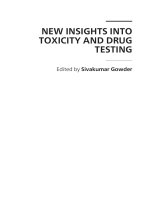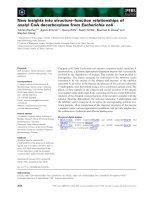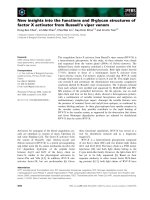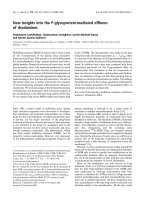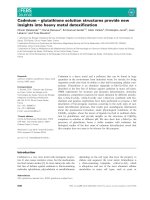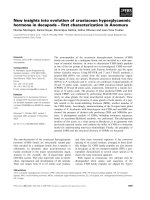NEW INSIGHTS INTO ANXIETY DISORDERS ppt
Bạn đang xem bản rút gọn của tài liệu. Xem và tải ngay bản đầy đủ của tài liệu tại đây (6.22 MB, 456 trang )
NEW INSIGHTS INTO
ANXIETY DISORDERS
Edited by Federico Durbano
New Insights into Anxiety Disorders
/>Edited by Federico Durbano
Contributors
Clare S Rees, Rebecca Anderson, Guillem Pailhez, Antonio Bulbena, Daisuke Nishi, Yutaka Matsuoka, Richard Servatius,
Meghan Caulfield, John Scott Price, Federico Durbano, Roberta Anniverno, Anna Boyajyan, Gohar Mkrtchyan, Lilit
Hovhannisyan, Diana Avetyan, Ghassan El-Baalbaki, Veronique Palardy, Claude Belanger, Catherine Fredette, Sylvain
Neron, Antonio Armario, Kevin Beck, Jennifer Catuzzi, Contreras, Nesrin Dilbaz, Aslı Enez Darcin, Jorge Javier Caraveo-
Anduaga, Maria Michail, Ebru Salcioglu, Metin Basoglu, Jasminka Juretić, Ivanka Zivcic
Published by InTech
Janeza Trdine 9, 51000 Rijeka, Croatia
Copyright © 2013 InTech
All chapters are Open Access distributed under the Creative Commons Attribution 3.0 license, which allows users to
download, copy and build upon published articles even for commercial purposes, as long as the author and publisher
are properly credited, which ensures maximum dissemination and a wider impact of our publications. After this work
has been published by InTech, authors have the right to republish it, in whole or part, in any publication of which they
are the author, and to make other personal use of the work. Any republication, referencing or personal use of the
work must explicitly identify the original source.
Notice
Statements and opinions expressed in the chapters are these of the individual contributors and not necessarily those
of the editors or publisher. No responsibility is accepted for the accuracy of information contained in the published
chapters. The publisher assumes no responsibility for any damage or injury to persons or property arising out of the
use of any materials, instructions, methods or ideas contained in the book.
Publishing Process Manager Iva Simcic
Technical Editor InTech DTP team
Cover InTech Design team
First published March, 2013
Printed in Croatia
A free online edition of this book is available at www.intechopen.com
Additional hard copies can be obtained from
New Insights into Anxiety Disorders, Edited by Federico Durbano
p. cm.
ISBN 978-953-51-1053-8
free online editions of InTech
Books and Journals can be found at
www.intechopen.com
Contents
Preface IX
Section 1 General Issues 1
Chapter 1 An Evolutionary Perspective on Anxiety and Anxiety
Disorders 3
John Scott Price
Chapter 2 Anxiety: An Adaptive Emotion 21
Ana G. Gutiérrez-García and Carlos M. Contreras
Section 2 Basic Research 39
Chapter 3 Focusing on the Possible Role of the Cerebellum in Anxiety
Disorders 41
Meghan D. Caulfield and Richard J. Servatius
Chapter 4 Searching for Biological Markers of Personality: Are There
Neuroendocrine Markers of Anxiety? 71
Antonio Armario and Roser Nadal
Chapter 5 Alterations in the Immune Response, Apoptosis and Synaptic
Plasticity in Posttraumatic Stress Disorder: Molecular Indicators
and Relation to Clinical Symptoms 105
Anna Boyajyan, Gohar Mkrtchyan, Lilit Hovhannisyan and Diana
Avetyan
Chapter 6 Understanding the Causes of Reduced Startle Reactivity in
Stress-Related Mental Disorders 135
Kevin D. Beck and Jennifer E. Catuzzi
Section 3 Clinical Issues: Old Problems New Ideas 171
Chapter 7 Social Anxiety Disorder in Psychosis: A Critical Review 173
Maria Michail
Chapter 8 Social Anxiety, Beliefs About Expressing Emotions and
Experiencing Positive Emotions 189
Jasminka Juretić and Ivanka Živčić-Bećirević
Chapter 9 Co-Morbid Anxiety and Physical Disorders: A Possible
Common Link with Joint Hypermobility Syndrome 213
Guillem Pailhez and Antonio Bulbena
Chapter 10 Anxiety Syndromes and Their Correlates in Children and
Adolescents: A Two-Year- Follow-Up Study at Primary Health
Care in Mexico City 233
Jorge Javier Caraveo-Anduaga, Alejandra Soriano Rodríguez and
Jose Erazo Pérez
Chapter 11 Anxiety Disorders in Pregnancy and the
Postpartum Period 259
Roberta Anniverno, Alessandra Bramante, Claudio Mencacci and
Federico Durbano
Chapter 12 Understanding and Treating Anxiety Disorders in Presence of
Personality Disorder Diagnosis 287
Véronique Palardy, Ghassan El-Baalbaki, Claude Bélanger and
Catherine Fredette
Section 4 Therapies: New Approaches and Insights 325
Chapter 13 Treatment of Generalized Anxiety Disorders:
Unmet Needs 327
Nesrin Dilbaz and Aslı Enez Darcin
Chapter 14 Using Hypnosis in the Treatment of Anxiety Disorders: Pros
and Cons 343
Catherine Fredette, Ghassan El-Baalbaki, Sylvain Neron and
Veronique Palardy
ContentsVI
Chapter 15 Current State of the Art in Treatment of Posttraumatic Stress
Disorder 379
Ebru Şalcıoğlu and Metin Başoğlu
Chapter 16 PTSD and the Attenuating Effects of Fish Oils: Results of
Supplementation After the 2011 Great East Japan
Earthquake 407
Daisuke Nishi, Yuichi Koido, Naoki Nakaya, Toshimasa Sone, Hiroko
Noguchi, Kei Hamazaki, Tomohito Hamazaki and Yutaka Matsuoka
Chapter 17 New Approaches to the Psychological Treatment of Obsessive-
Compulsive Disorder in Adults 427
Clare Rees and Rebecca Anderson
Contents VII
Preface
The contributing authors have done their best to be clear and exhaustive enough about
their topics. I will give a brief panorama on the structure of the work, just to introduce
the chapters accepted for this publication.
Anxiety and panic disorders have now reached the size of a pandemic: a third of the
western world and a substantial part of that global world that is facing to the modern
(western) world suffer of pathological anxiety more or less seriously. According to
NIMH data, onset of anxiety disorders is the earliest of all mental disorders (11 yrs age),
and the 12-months prevalence in USA is 18.1% of adult population (of them, about 23%
is graded serious or very serious). Women overtake men by 60%. And in the last decade,
the whole world has experienced a series of man-made and natural disasters. Large
numbers of people have therefore been exposed directly or (peculiarity of the modern
world) via mass-media to potentially traumatic events, increasing dramatically the im‐
portance of anxiety in modern world. According to these data, the questions about what
is the meaning of the phenomenon and what should be its management is an increasing
measure of the inefficiency of the current therapeutic approaches, individually oriented
and based on old approaches to an expanding and less and less individual problem.
We must bear in mind, however, that fear and anxiety are normal part of life. You may
feel anxious before you take a test or walk down a dark street. This kind of anxiety is
useful and adaptive - it makes you more alert or careful, saving your life in certain
circumstances. Normally, it ends soon after you are out of the situation that caused it.
But for millions of people, this anxiety does not go away, and gets worse over time,
leading
to a general malfunctioning of their somatopsychic integrity. The first part of
this book therefore describes very well and very deeply the evolutionary meaning of
anxiety and the adaptive value of anxious emotions. According to ethology, anxiety is a
normal reaction to stress being actually beneficial in some situations. For some people,
however, anxiety can become excessive, and while the person suffering may realize it is
excessive they may also have difficulty controlling it and it may negatively affect their
day-to-day living.
The chapters of the second part of the book are centered on the biological basis of anxi‐
ety, specifically on the role of the increasingly understood role of the “black box” cere‐
bellum and of the alert circuits, of the disregulation of neuroendocrine functioning in
personality disorders associated with anxiety behaviors, and of the role of inflammatory
mediators in anxiety reactions; these are the most recent evidences on the developments
of basic research on anxiety disorders, and are all written by clinical psychiatrist, under‐
lining the importance that basic research has gained in recent years for an effective and
efficient clinical practice.
After that, a third section explores some emerging clinical problems associated with anxi‐
ety disorders. A very interesting one is the description and discrimination of social anxi‐
ety and psychosis, very often social anxiety being confused with interpersonal
hypersensitivity and some forms of paranoia. But also social anxiety is a dimension of
paranoia, and a correct definition of the problem is of main interest for a correct therapeu‐
tic intervention. Being social anxiety an increasing problem affecting modern society, and
being at the basis of drug abuse consumption and of other dissocial behaviors in order to
counteract it, great efforts have spent to understand the concept of social anxiety, and a
very important issue of research is about expressing and understanding emotions. The
theme is very well developed in the third part of this book, exploring the peculiar modali‐
ties with which social anxious people express negative emotions and are unable to under‐
stand their inner positive emotions and beliefs. Another important issue regards the
connection between anxiety and physical illness, specially because the main symptomatic
expression of anxiety is physical (muscular tension, cardiovascular hyperactivation, vege‐
tative symptoms). A particular aspect of modern psychosomatic research is the etiopatho‐
genetic correlation between anxiety development and expression in some “medical”
illnesses: one chapter of this book describes the correlation between inflammatory diseas‐
es of connective tissue (joint hypermobility syndrome), another one describes the peculiar
manifestations of anxiety in prepartum and puerperium (exploring the most recent data
on pharmacological treatment in these delicate periods of women life), and another chap‐
ter presents the problems of treating anxiety in personality disorders.
The last part of the book is therapeutically oriented. A lot of efforts have spent to ach‐
ieve some results in PTSD, facing the increasing exposure to dramatic and terrifying
events in modern world (television transmitted wars and natural disaster has a great
role in the exploding and expanding manifestations of PTSD, or at least in hypersensibi‐
lize people). Here a clinical research group faced the consequences of Japanese tsunami,
and tried to found an efficient and efficacious treatment to be administered in
a short
time to a great number of people in order to counteract the potentially pathological ef‐
fects of a disaster. Another chapter describes the state of the art of hypnosis, trying to
give some explanations about its mechanisms of action and efficacy; another one de‐
scribes the psychological treatments of OCD, with a clear CBT oriented position, but de‐
scribing also the limitations of some cognitive-behavioral approaches using evidence
based methods. Last but not least, a chapter is centered on the unmet needs of the treat‐
ment of anxiety.
As the reader can see, there is a sort of red line which connects the different topics
covered by this publication: anxiety as a normal psychological condition, but with po‐
tential pathological outcomes especially in the social domain (relational – social anxi‐
ety; functional – personality disorders; ambiental – PTSD), not forgetting the ones in
physical functioning.
All the authors (all clinicians, I wish to remember) made their best to fulfill the objec‐
tives of this collaborative publication, and to all of them a special thanks for their work
and for their contribution to an increase of scientific knowledge deeply rooted in clinical
practice, which is what everyone of us needs in his daily practice.
PrefaceX
A special thanks to InTech, too, which gave the possibility to have this publication and
efficaciously supported the authors in the editing process.
Have a good reading.
Federico Durbano
Nursing School of University of Milan
C. Cattaneo University of Castellanza
Emergency Psychiatric Service of Fatebenefratelli Hospital,
Milan, Italy
Preface XI
Section 1
General Issues
Chapter 1
An Evolutionary Perspective on Anxiety and Anxiety
Disorders
John Scott Price
Additional information is available at the end of the chapter
/>1. Introduction
Anxiety and depression are two of the negative emotions described by Levenson (1994).
These emotions, along with anger, tend to disrupt the emotional homeostasis of the body,
while the positive emotions such as contentment tend to restore homeostasis. The actions of
anxiety and depression may be synergistic but they differ in important respects. Anxiety
usually has an obvious cause and also a goal (safety, and the avoidance of danger), whereas
depression usually has no obvious cause and also has no goal. Depression is thought to be
related to social factors in relation to other human beings, whereas anxiety is related partly
to social situations but also to non-social dangers. The strategies for dealing with human
danger include submission, whereas this is not an appropriate response to non-human dan‐
ger. Anxiety is classically thought to be concerned with the threat of danger, whereas de‐
pression is thought to be the result of danger. I will describe later how the negative
emotions can be divided into the escalating emotions such as anger and the de-escalating
emotions of anxiety and depression
In a recent monograph, Bruene (2008) says, “Behavioral observation of patients with anxiety
disorders suggests that these disorders – as a group – reflect exaggerated responses to inter‐
nal or external signals of perceived danger or threat. The autonomic part of the anxiety re‐
sponse pattern prepares the organism for one of several response options to terminate the
anxiety-eliciting situation, namely, flight, immobility, submission or aggression.”
An evolutionary approach to any behaviour (including anxiety and other forms of psycho‐
pathology) refers to two separate “causes”. One is the question of function. What is the func‐
tion of this behaviour, if any? Why has it evolved? What adaptive advantage does it give to
the individual, or the individual’s close kin, or to the individual’s social group? This ap‐
proach relies on behavioural ecology, which is the study of the function of behaviour, and
© 2013 Price; licensee InTech. This is an open access article distributed under the terms of the Creative
Commons Attribution License ( which permits unrestricted use,
distribution, and reproduction in any medium, provided the original work is properly cited.
the evolution of alternative behavioural strategies (Troisi, 2005). The other question is its
phylogenetic origin. How did it evolve in our ancestors, and does it occur in other species?
Clearly the fossil record does not record anxiety, and whether it occurs in our immediate-
return hunter-gatherer ancestors has not been adequately studied. So the occurrence of anxi‐
ety in other species is of interest, bearing in mind that behaviour can be very different in
closely related species, such as the absence or presence of paternal behaviour in some ro‐
dents (e.g., montane vs. prairie voles).
These two questions, the function of behaviour and its phylogenetic origin, are two of the
four questions which Tinbergen famously asked of any behaviour in order to understand it
properly (Tinbergen, 1963): What is its function, what is its phylogeny, what is its ontogeny,
what is its immediate causation? Of course, statements about the function of a behaviour
during evolution are in a different logical category from statements about proximal causa‐
tion, in that they cannot be verified empirically. This has led to negative comments from
some sources (e.g. Dubrovsky, 2002), caricaturing them as “just-so stories”, in the same cate‐
gory as Rudyard Kipling’s “How the leopard got its spots”; but if we did not ask how the
leopard got its spots, we might know a lot less about camouflage, colour vision and preda‐
tor-prey relations,
I wrote on this topic ten years ago, and since what I said than can be read free on the inter‐
net (Price, 2003) I will try not to repeat myself, but rather emphasise certain points and at‐
tempt to cover more recent thinking.
2. The adaptive function of anxiety
It is obvious that anxiety is adaptive in protecting the individual from danger. A person
who crossed Niagara Falls on a tightrope every day would not last long. In the UK we have
had many deaths from “tombstoning”, which means jumping off a high cliff into water (and
entering it vertically, like a tombstone). Anxious avoidance of snakes and spiders has clearly
saved lives, and the fact that there is no in-built anxiety about cars and electric sockets indi‐
cates that evolution has not had time to build up anxiety about these dangers. This is be‐
cause of a “mismatch” between the present and the Era of Evolutionary Adaptation (EEA),
which is the evolutionary time in which adaptations evolved.
I will write about the triune brain (McLean, 1990; Ploog, 2003). Although Paul McLean’s
ideas have been trashed by his successors in neuroanatomy (Wikipedia), and they do not fit
well with the neuroanatomy of vocalisation (Newman, 2002), I think that some of his ideas
are helpful, especially his idea of the forebrain consisting of three “central processing assem‐
blies”, operating somewhat independently, and arranged in a rostro-caudal sequence in the
mammalian forebrain. This triune brain may well underlie the triune mind postulated by
philosophers such as Plato, Pascal and Gurdjieff. Although I discussed this matter ten years
ago, there is more to be said. One important finding is that the genetic tendency to general‐
ised anxiety disorder (GAD) and major depressive disorder is the same (Kendler et al., 1992;
Hettema et al., 2005), and so from an evolutionary view the arguments for one apply also to
New Insights into Anxiety Disorders4
the other. My own view is that anxiety and depression operate synergistically to manage so‐
cial change in small groups, but more of that in a later section.
First, I will illustrate how escalation and de-escalation can be hypothesised to occur relative‐
ly independently at the three levels of the triune brain. Each level makes its own decision,
when confronted by a threat or challenge, either to escalate or de-escalate:
Brain level Response to threat
Escalate or De-escalate
Rational level (isocortex) Decide to fight
(stubbornness or courage)
or Decide to flee or submit
(common sense)
Emotional level
(limbic system)
Anger, feel assertive and confident or ANXIETY, feel inferior ,
impotent,
Instinctive level
(basal ganglia)
Elevated mood or Depressed mood
Anxious mood, GAD
Table 1. Escalating and de-escalating strategies at three brain levels: agonistic competition.
Human competition is very different from animal competition, and most of the methods of
competition do not involve face-to-face encounters with rivals. Moreover, success is ach‐
ieved not by intimidating a rival, but by attracting positive responses from other members
of the group, resulting in prestige. Remarkably, the choices between escalation and de-esca‐
lation have survived the transition from agonistic to prestige competition, and so we can
emend Table 1 to express the new type of competition, as laid out in Table 2:
Brain level Response to competition
Escalate or De-escalate
Rational level (isocortex) Adopt new goals, actively pursue
existing goals, assert oneself, speak in
public
or Give up goals, efface oneself, refrain
from public speaking
Emotional level
(limbic system)
Feel assertive, exhilarated and
enthusiastic
or ANXIETY, feel inferior, ashamed,
writer’s block
Instinctive level
(basal ganglia)
Elevated mood or Depressed mood
Anxious mood, GAD
Table 2. Escalating and de-escalating strategies at three brain levels: prestige competition.
It should be clear that de-escalation at the rational level can pre-empt or terminate de-es‐
calation at the lower levels. These lower levels have evolved as a safety net in case the
rational brain is too ambitious. Therefore we often see patients who are escalating at the
An Evolutionary Perspective on Anxiety and Anxiety Disorders
/>5
rational level, but, their escalation being unsuccessful, the lower levels are accessed. We
also see patients who are escalating at the emotional level, and in spite of de-escalation
at the rational level, if the angry emotion does not achieve its aim, we then get de-esca‐
lation at the instinctive level. Most of these patients have suffered unjustified misfortune,
such as death of a child or being passed over in work by an incompetent member of the
family firm; they are denied the principle of retributive justice, as was Job in the Book of
Job of the Old Testament.
The idea of separating the negative emotions into escalatory and de-escalatory is not new.
Stone (2002) reports that “Maurice de Fleury (1897) divided the emotions into two groups.
Doubt, humility, sloth, fearfulness, sadness and pity are symptoms – to varying degrees – of
cerebral exhaustion; Pride, foolishness, anger, egoism, courage, heroism, and cruelty are the
manifestations of exaltation of the spirit.” (p. 9).
2.1. The anxiety-generating effect of bad news
I would like to re-emphasise the importance of “bad news” in the genesis of psychopatholo‐
gy, as this does not seem to be generally recognised. Bad news, of deaths and other disas‐
ters, is not available to our primate cousins who are not equipped to exchange gossip, but
has been available to our ancestors over the last few million years since language evolved.
Since these ancestors lived in groups of about 150 individuals, the amount of bad news they
could generate was limited, even if we add in bad news from neighbouring groups. Now,
we have available the bad news of many billions of people. Since news of death or other dis‐
aster may presage the nearby existence of a predator or of raiding parties from neighbouring
tribes, or of disease, it must have been adaptive for bad news to increase anxiety and pro‐
mote activities to ward off occurrence, such as increased washing, checking of security ar‐
rangements, and the advantageous territorial constriction of agoraphobia.
In the EEA bad news was probably discussed and so shared with other group members,
whereas modern man tends to watch it or listen to it on his own, or at least without com‐
ment. Things are worse when the bad news is close by. An Egyptian psychiatrist (Nagy,
2012) reports on a patient who was glued to her TV set, absorbing the chaos all around her;
and the situation was dire: two of the psychiatrist’s students were killed while trying to save
injured protesters.
When I practiced as a clinician, I advised all my anxious patients to avoid watching TV
news, and I found that many of them had learned the lesson for themselves. They realised
that each item of bad news raised their background level of anxiety, and, of course, severely
depressed patients may believe that they are personally responsible for the disasters which
occur daily around the globe.
There is a need for controlled study of the effect of reducing patients’ access to bad news,
and this is difficult in modern conditions when family television has replaced games and
conversation for family interaction. I make a point of advising my anxious patients to re‐
strict their viewing to comedies and nature programmes, although this injunction may cause
family arguments, if other members of the family have a different viewing agenda. This is
New Insights into Anxiety Disorders6
yet another argument for treating patients in family groups, so that the whole family can be
motivated to protect the patient from the horrors of contemporary life. No one, to my
knowledge, has done a controlled trial of “news avoidance” as an item of therapy.
2.2. Growing up with anxiety
A lot of variation in neuroticism (the personality equivalent of anxiety-proneness) is due to
genetic factors and to non-shared environmental experience, negating the folk psychology
view that children are strongly influenced by the behaviour of their parents and the atmos‐
phere of the family home. Some genotypes prosper under negative home circumstances,
whereas others suffer under those circumstances, but prosper more than the “tough ones”
when the environment is benign (Bruene et al., 2012). This confirms the old observation that
some children do better with the stick, and others with the carrot. We need to improve our
means of distinguishing these two genotypes early in childhood.
I will say something about the genesis of anxiety in adolescence. Much good work has been
done on the establishment of a secure base for the child in infancy (Price, 2000), but less has
been done on adolescence, which in my clinical experience is a strong divider into the happy
and the miserable. Some young people take to adolescence like a duck to water, and they are
accepted by their adolescent peers and given positions of influence and even leadership in
their groups. Others do badly at this time, and are bullied unmercifully by both boys and
girls, that by boys tending to be physical, that by girls tending towards social exclusion.
Normal children entering adolescence may be disadvantaged for many reasons; they may be
odd in some way, speak with an unusual accent, have some physical deformity, or maybe
they have moved into an area where the adolescent group is already full and does not want
new recruits. For those who have suffered anxious or avoidant attachment in infancy, the
problems of adolescence are compounded (Wilson, Price & Preti, 2009).
2.3. Social anxiety disorder (SAD)
Social anxiety disorder (SAD) is an exaggeration of the normal submissive or appeasement
display which people make to more powerful individuals or to a disapproving group. Ka‐
miner and Stein (2005) point out that SAD is an excessive fear of humiliating or embarrass‐
ing oneself while being exposed to public scrutiny or to unfamiliar people, resulting in
intense anxiety upon exposure to social performance situations. Feared social situations are
either avoided as much as possible or create significant distress. Physical manifestations of
anxiety in the feared situations include a shaky voice, clammy hands, tremors and blushing.
In the generalized sub-type of SAD, anxiety is associated with most social situations (includ‐
ing both formal performance situations such as giving a speech or speaking at a meeting,
and informal social interactions such as initiating conversations, attending parties or dat‐
ing); in the non-generalized sub-type, anxiety occurs only in specific social situations, such
as public speaking, or eating/drinking in public, or writing in public. Prevalence rates for
SAD range from 3% to 16%. From an evolutionary point of view, SAD must promote group
functioning by reducing social competition, and ensuring that group discussions in the
council chamber do not last indefinitely. Most readers will be aware that in question time
An Evolutionary Perspective on Anxiety and Anxiety Disorders
/>7
after a scientific paper, the people who ask questions are those who have social confidence
and like the sound of their own voices, regardless of their knowledge of the subject, whereas
many of those with something important to say remain silent because of SAD.
3. Anxiety in other species
Anxiety is the emotion associated with avoidance of danger, and it is obvious that many
species encounter more danger than ourselves. Humans are sometimes taken by tigers and
other predators, but many species are subject to constant predation, being the basic diet of
the predator species. Can we learn from their reactions? One obvious defensive measure is
to have a safe haven, especially at night. Some species avoid danger by being enclosed, oth‐
ers by being exposed. An extreme example of being enclosed is the naked mole rat, which
does not appear above the surface of the earth. Rabbits avoid danger to their young by visit‐
ing them for suckling only once a day, and ferrets are more extreme in suckling only once in
48 hours. In this way they avoid giving predators a clue as to the whereabouts of their bur‐
row, and this advantage clearly outweighs the advantage of constant maternal care. When
kept in cages, rabbit and ferret mothers cannot do this, which may account for some of the
aggressiveness they show at this time. Some species prefer to be exposed, such as the hama‐
dryas baboon which sleeps on a cliff face, and many birds nest on cliffs for the same reason.
Some humans adopt both strategies, and live in caves which open onto the cliff face, and in
this case either acrophobia or claustrophobia would be a disadvantage.
A lot of information about animal anxiety is available informally on the internet: just Google
“anxiety in horses (or monkeys, or birds, etc.)”. Different animals have different sources of
anxiety and different reactions to it; for instance, horses suffer from severe separation anxi‐
ety, and this no doubt originated in their need to stay with their herd.
Some group-living species delegate the role of anxious individual to one of their members,
so that the rest can forage free from anxiety. We have all seen films of meerkats in which the
group forages happily while one member stands on a mound and looks anxiously for birds
of prey and terrestrial predators. This delegation of responsibility may be important for hu‐
mans. If a foraging meerkat does not trust the sentry, the freedom from anxiety may be lost.
If the obsessional housewife does not trust her cleaning lady, she is likely to repeat the work
while nursing pathological grievance against her employee.
3.1. Phylogeny of anxiety
In an intriguing chapter, Hofer (2002) describes the response to danger in organisms of vary‐
ing complexity. The bacterium swims forward with its flagella working together, absorbing
molecules of sucrose and other foodstuffs. However, if receptors on its surface detect a tox‐
in, its flagella then act independently, and the bacterium tumbles about. In half a second, it
has forgotten about the toxin and sets off with flagella all pulling together, in whatever di‐
rection it happens to be pointing at the time. Hofer comments: “When it stops and tumbles
in response to the presence of a negative signal, is it anxious? Certainly, we would not want
New Insights into Anxiety Disorders8
to say so, even though the mental picture of a tumbling creature with flagellar hairs stand‐
ing on end may be intuitively persuasive… The presence of these behaviors in so primitive
an organism gives us an idea of how basic a state resembling anxiety has been for survival
of life forms.”
Hofer also discusses the invertebrate sea hare, Aplysia californicus. It can be conditioned to
respond with avoidance to shrimp juice by associating it with electric shocks (mimicking its
predator, the starfish), thus producing a state of anticipatory anxiety, but in the absence of
shrimp juice (the conditioned stimulus) its behaviour is normal. However, a series of uncon‐
trollable electric shocks produces a “persistent state (lasting several weeks) in which defen‐
sive and escape responses were exaggerated, and responses to positive events were blunted,
an abnormal behavioral repertoire had been established that resembled a form of chronic
diffuse anxiety.”
The development of the limbic system in mammals allowed new and social forms of
anxiety to evolve. Rat pups emit high frequency squeaks when separated from their
mother and these sounds release searching and retrieval behaviour in the mother. In his
own work, Hofer was able to breed strains of rats with high and low tendency to emit
squeaks. He speculates that the ability to squeak evolved to keep the rats warm, and on‐
ly secondarily became a signal to the mother (exaptation). The squeaks are inhibited by
benzodiazepines and opioids, and exacerbated by benzodiazepine antagonists. In later
work (Brunelli & Hofer, 2007) the high squeak infant rats developed into nervous adults,
while the low squeak rats were notable for their aggression, so there had presumably
been selection for escalation versus de-escalation in the emotional (limbic) forebrain. Pre‐
sumably, rabbit and ferret pups do not respond to separation in this way, otherwise they
would attract predators to their burrow.
Turning to primates, Hofer describes Suomi’s work on free-ranging rhesus macaques on an
island in the Caribbean. This population contained a sub-population of very anxious indi‐
viduals, some of whom suffered from “lasting incapacitating states resulting in substantial
mortality”. The anxious traits could be increased by selective breeding and prevention of
good mothering. He describes the response to “chronically threatening conditions. Persis‐
tent anxiety (high levels of arousal, searching for cues for danger, and high levels of avoid‐
ance of potentially damaging encounters) confers an adaptive advantage over less anxious
individuals.” There has been criticism of Suomi’s work on humanitarian grounds.
In the case of humans, Hofer describes the speculation of Klein that panic attacks may
be a response to imminent suffocation, mediated by high levels of blood carbon dioxide.
Hyperventilation (overbreathing) is a common feature of panic attacks, and may aggra‐
vate the panic by causing tetany due to low levels of carbon dioxide and thus an exces‐
sively alkaline blood.
My own extensive experience of patients with panic attacks resulted from an appointment
as medical casualty officer in a hospital near an underground railway station in London.
Two or three patients a day were brought by ambulance from the station, having developed
panic in the underground, especially when it was crowded and the train stopped between
An Evolutionary Perspective on Anxiety and Anxiety Disorders
/>9
stations. These patients had very rapid respirations which caused involuntary contraction of
muscles and sensations of tingling due to the alkalinity of the blood due to loss of carbonic
acid due to overbreathing. Of course, these symptoms aggravated the panic and most of the
patients thought they were dying. Their condition was rapidly cured by getting them to
breathe into a paper bag, so that they were rebreathing their own carbon dioxide. Talking to
these patients when they had recovered, it was clear that most of them were healthy young
adults who had no history of excessive anxiety or any other psychiatric disorder.
Hofer concludes by pointing out that patients may benefit by being told that they are suffer‐
ing from, not madness, but from a mechanism that has enabled their ancestors to survive the
dangers of our evolutionary past.
4. Genetics
A lot of excitement has been caused by the discovery of a polymorphism in the seroto‐
nin transporter gene (which enables the reuptake of serotonin into the presynaptic neu‐
ron),because most of our effective antidepressant drugs inhibit the reuptake of serotonin.
Equally exciting is the possibility that there is a gene/environment interaction in its effect
(Risch et al., 2009). It has been suggested that the “short” allele of the serotonin trans‐
porter coding gene is associated with greater risk for depression if linked with early
childhood adversities, yet the same version of the gene is associated with reduced risk for
depression if carriers grow up in emotionally secure conditions (Belsky & Pluess, 2009).
This suggests that selection favoured plasticity or “open programs” that render individu‐
als more susceptible to environmental contingencies – for better and worse (Belsky, Jon‐
assaint & Pluess, 2009). Similarly, psychiatrists guided by evolutionary theory have
recognized that antagonistic pleiotropy may play a role in psychiatric disorders – genes
that convey fitness advantages in one domain, while having potentially maladaptive val‐
ue in another domain, a concept that was originally put forth with regard to senescence
(Bruene et al., 2012). Nowadays, examples for antagonistic pleiotropy can be pinned
down to even single genes such as the catecholamine-O-methyltransferase coding gene,
of which one particular allele is associated with poorer working memory performance
but superior empathy (Heinz & Smolka, 2006)). Taken together, these insights offer an
answer to the question of why natural selection designed bodies that are – under specific
circumstances – vulnerable to disease (Nesse & Williams, 1994). There have been several
hundred studies of the serotonin transporter gene in various psychiatric populations and
consistent results are not easy to obtain (Duncan & Keller, 2010).
I mentioned above some findings from the large Virginia twin study carried out by Ken‐
dler and his colleagues (Hettema, Prescott, Myers et al., 2005). They found that the ge‐
netic predisposition to major depressive disorder was the same as that to generalised
anxiety disorder and to panic disorder. There was some overlap with social anxiety dis‐
order and agoraphobia, but the genetic predisposition to specific phobias was separate.
This means that if one is predisposed by genetics to major depressive disorder, one is
New Insights into Anxiety Disorders10
equally predisposed to general anxiety disorder (GAD), but the same cannot be said for
lesser degrees of anxiety.
4.1. The serotonin transporter gene in macaques.
Humans and macaques are the only primates to have the short version of the serotonin
transporter gene. 48% of Caucasian populations are heterozygotes, having both short and
long alleles. 36% are homozygotes for the long allele, 16% for the short allele. Rhesus mon‐
keys who possess the short allele are notably more anxious than the long homozygotes
(Watson et al., 2009). Moreover, when shown pictures of dominant monkeys, their pupils di‐
late more than those who are homozygous for the long allele, and they have to be bribed
(with juice) to see the face of a dominant monkey, whereas the long homozygotes will fore‐
go juice in order to see the same pictures. The rearing of these monkeys is not described, so
it is difficult to compare with the human data mentioned above.
4.2. Anxiety in different human cultures
I am not an anthropologist, but it is clear from the literature that some cultures have differ‐
ent attitudes to anxiety and maybe different genetic predispositions. Margaret Mead (1935)
studied three tribes living in the Sepik River Valley of Papua New Guinea. The Mundugu‐
mor were very aggressive and warlike, so that anxiety was not a desirable feature with them
(but the actual frequency of anxiety is not known). The Arapesh were extremely peaceful.
The Tchambuli were also peaceful and the men spent their time putting on plays. The two
latter tribes had been driven out of the fertile areas of the island.
The Tarahumara of Mexico (McDougall, 2010) are reported to be extremely nervous and in‐
hibited, so that any social contact requires large quantities of corn beer to be consumed.
They are famous for their utrarunning (running more than marathon distances), and possi‐
bly they seek the “runner’s high” (thought to be due to the release of endogenous opioids)
to counter their natural timidity.
Also very nervous are the Chewong of the Malaysian Peninsular, and in this tribe the ad‐
mired norm of behaviour is to be timid (Howell, 2012). It is said that the elders are fond of
telling stories about the times they have run away. Asiatics may have higher frequencies of
the short version of the serotonin transporter gene than Europeans (Watson et al., 2009).
5. Anxiety and its resolution in a sacred text
For reasons of confidentiality, we cannot present case histories from our practice, but fortu‐
nately there is a clear account of an anxiety attack and its resolution in the Hindu epic poem,
the Mahabharata (Price& Gardner, 2009). The poem describes a long and bitter struggle be‐
tween two sets of cousins, the Pandavas and Kauravas, for control of ancestral lands. The
Bhagavad Gita (a small part of the Mahabharata) begins with the two armies drawn up for
battle with warriors blowing conches and beating drums. Arjuna, a younger Pandava broth‐
An Evolutionary Perspective on Anxiety and Anxiety Disorders
/>11
er renowned as an archer, drives his chariot between the armies to assess the opposition. His
charioteer is none other than the god Sri Krishna. As Arjuna views the superior Kaurava ar‐
my, he sees relatives and mentors he knows well. He feels doubts about killing these family
members and friends, translated by Mitchell (2002) as follows:
Arjuna saw them standing there: fathers, grandfathers, teachers, uncles, brothers, sons,
grandsons, fathers-in-law, and friends, kinsmen on both sides, each arrayed against the oth‐
er. In despair, overwhelmed with pity, he said: “As I see my own kinsmen, gathered here,
eager to fight, my legs weaken, my mouth dries, my body trembles, my hair stands on end,
my skin burns, the bow Gandiva drops from my hand. I am beside myself, my mind reels. I
see evil omens, Krishna; no good can come from killing my own kinsmen in battle. I have no
desire for victory or for the pleasures of kingship” … Having spoken these words, Arjuna
sank down into the chariot and dropped his arrows and bow, his mind heavy with grief…
As Arjuna sat there, overwhelmed with pity, desperate, tears streaming from his eyes,
Krishna spoke these words to him: “Why this timidity, Arjuna, at a time of crisis? It is un‐
worthy of a noble mind; it is shameful and does not lead to heaven. This cowardice is be‐
neath you, Arjuna; do not give in to it. Shake off your weakness. Stand up now like a man.”
Arjuna said: “When the battle begins, how can I shoot arrows through Bhishma and Drona,
who deserve my reverence? …… I am weighted down with pity, Krishna; my mind is utter‐
ly confused. Tell me where my duty lies, which path I should take. I am your pupil; I beg
you for your instruction. For I cannot imagine how any victory – even if I were to gain the
kingship of the whole earth or of all the gods in heaven – could drive away this grief that is
withering my senses.”
Having spoken thus to Krishna, Arjuna said: “I will not fight,” and fell silent.
As Arjuna sat there, downcast, between the two armies, Krishna smiled at him, then spoke
…
The god Krishna, the eighth avatar of Vishnu, then speaks to Arjuna for 16 more chapters
(and the reader is left to wonder what the two armies are doing during this time). In a verbal
dominance display of unparalleled beauty (except possibly for the speech of the Lord out of
the whirlwind in the book of Job), Krishna explains to Arjuna that he is all-powerful, and
then he displays himself to Arjuna in all his divine majesty. Arjuna is overwhelmed and
submits to Krishna, saying “I will do as you command”. He then recovers from his anxiety
attack and fights heroically in the ensuing battle.
In this example we see a distressing situation lead to a severe panic attack, a request for ad‐
vice which is not followed, a dominance display by the god followed by total submission on
the part of Arjuna and then recovery from anxiety. By abrogating responsibility to Krishna
at the rational level of his triune mind, Arjuna no longer needs the anxiety which arose from
his emotional mind due to the initial failure of the rational mind to deal with the problem
(by taking Krishna’s advice).
New Insights into Anxiety Disorders12
5.1. Anxiety and art
Although artists can portray frightening scenes, it is less easy for them to depict the anxiety
response. Here is a comment by Edvard Munch about his famous (and expensive) painting
“The Scream”:
"I was walking down the road with two friends when the sun set; suddenly, the sky turned
as red as blood. I stopped and leaned against the fence, feeling unspeakably tired. Tongues
of fire and blood stretched over the bluish black fjord. My friends went on walking, while I
lagged behind, shivering with fear. Then I heard the enormous, infinite scream of nature."
He later described the personal anguish behind the painting, "for several years I was almost
mad… You know my picture, 'The Scream?' I was stretched to the limit—nature was
screaming in my blood… After that I gave up hope ever of being able to love again." (Wiki‐
pedia).
5.2. Social presentation of the anxious person
Anxious patients may not appear anxious to others, but may be seen as aloof or even arro‐
gant. Leahy (2010) puts it as follows::
“People with social phobia or social anxiety often give out signals of their own apprehen‐
sion that inadvertently send the wrong message. For example, many of my patients over the
years with social anxiety often don't smile, they avoid eye contact, and they remain silent
because they are so anxious that they will either sound foolish or look anxious. Ironically,
these attempts to remain "closed" result in the "wrong impression". Many of these people
appear to be cold and aloof-and, in some cases, conceited. It's the wrong message and they
don't even know they are sending it. Ironically, they fear that they will appear anxious, but
they actually appear arrogant. They also fail to "mirror" or "match" the emotions that others
are displaying. For example, other people may be smiling, but the anxious person may re‐
main cool and aloof. This sends the wrong message - that you are not interested and you
don't care.”
One of my first patients was just such a young man, seen as aloof by fellow patients in a
neurosis unit (Sainsbury and Price, 1969). Asked to paint “Myself and the group” in art ther‐
apy, he drew a circle of red blobs representing the group and a single black blob represent‐
ing himself. In the group discussion the next day, the other patients said that they had
thought he felt himself superior to them, but in the ensuing discussion he disabused them of
this idea and was then accepted by the group. This is similar to the misperception of de‐
pressed patients, who are seen, not as depressed, but as lazy because they do not perform
tasks well, or rude because they do not carry out social obligations such as writing thank-
you letters.
The concealment of anxiety is a promising line of study. A chimpanzee in a conflict situation
has been seen literally wiping the submissive grin off his face with his hand. Some tribes cut
the muscles around the mouth to prevent the manifestation of a trembling lip. The conceal‐
ment and detection of anxiety is to be found expressed in the novels of Georgette Hayer.
Anxious young people may hide their anxiety from their parents, perhaps hiding scars on
An Evolutionary Perspective on Anxiety and Anxiety Disorders
/>13
